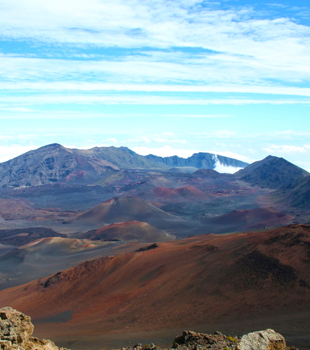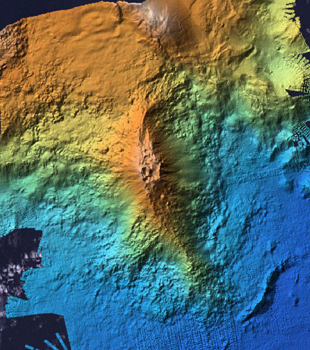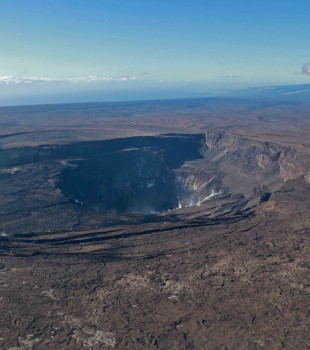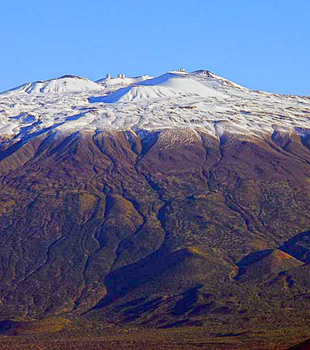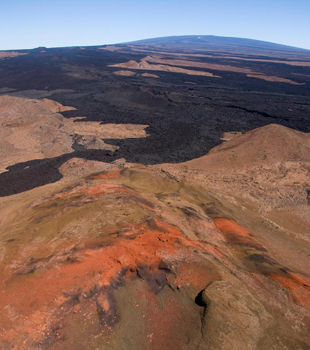Quick Links
Hawaiian Volcano Observatory's mission
HVO monitors the active volcanoes in Hawaii, assesses their hazards, issues warnings, and advances scientific understanding to reduce impacts of volcanic eruptions.
Hawaiian Volcano Observatory's mission
HVO monitors the active volcanoes in Hawaii, assesses their hazards, issues warnings, and advances scientific understanding to reduce impacts of volcanic eruptions.
HVO News (archive)
Active Volcanoes in Hawaii1
New USGS Data Release - Campaign GPS measurements on the Island of Hawai‘i collected by the Hawaiian Volcano Observatory in 2019
September 08, 2020
The USGS has recently published a "Campaign GPS measurements on the Island of Hawai‘i collected by the Hawaiian Volcano Observatory in 2019." This data release includes all 2019 campaign survey GPS sites on Kīlauea and Mauna Loa on the Island of Hawai‘i; it also includes semi-permanent stations in Kīlauea's Middle East Rift Zone that were occupied all year. GPS surveys are conducted annually by the Hawaiian Volcano Observatory to supplement permanent and semi-permanent GPS stations providing data on ground deformation. This data release includes data from a total of 69 sites that were occupied. All data (raw and rinex) are included along with metadata and log sheets.
New USGS Data Release - Sulfur dioxide emission rates from Kīlauea Volcano, Hawaii, 2008-2013
September 08, 2020
The USGS has recently published a data release that completes the 1979–2018 sulfur dioxide emission rate record for Kīlauea Volcano, Hawaii. Kīlauea Volcano on the Island of Hawai‘i, has one of the longest running volcanic sulfur dioxide gas (SO2) emission rate records in the world. The volcano was in a state of nearly continuous eruption from 1983–2018, emitting large amounts of gas from the volcano's East Rift Zone (ERZ) during the entire eruptive period, and from the Overlook vent at the summit from 2008–2018. This data release presents our best estimates for ground-based SO2 emission rates from the two gas emission sources for the period 2008–2013. It provides revised data for previously published 2008–2010 emission rates and fills in the existing 2011–2013 data gap.
A look at the past year of Kīlauea's summit water lake
July 24, 2020
Water was first observed at the summit of Kīlauea Volcano, within Hawai‘i Volcanoes National Park, one year ago. Since then, the body of water has slowly deepened and grown in size. The Hawaiian Volcano Observatory continues to monitor the lake, and have summarized one year of observations. Additional resources are available on the Kīlauea summit water webpage. Kīlauea Volcano remains at alert-level NORMAL and aviation color-code GREEN. Levels of seismicity, deformation, and gas emission remain at background levels.
New USGS Data Release - Digital elevation model of Kīlauea Volcano, Hawai‘i, based on July 2019 airborne lidar surveys
July 09, 2020
The USGS has recently published a "Digital elevation model of Kīlauea Volcano, Hawai‘i, based on July 2019 airborne lidar surveys." The surveys covered 219 square miles (567 sq km) and included Kīlauea Volcano's summit, lower East Rift Zone, and middle East Rift Zone (including the entire Pu‘u ‘Ō‘ō lava flow field active from 1983 through early 2018). This USGS data release contains a 1-meter resolution raster digital elevation model (DEM) of the ground surface, including beneath-forest cover ('bare earth'). The DEM can support a variety of earth science, civil engineering, and land-use investigations.
Updates to HVO's Kīlauea and Mauna Loa "Geology & History" Webpages
June 08, 2020
HVO has updated the Geology & History webpages for Kīlauea and Mauna Loa volcanoes. These pages now include maps and links to revised tables summarizing volcanic activity over the past ~200 years at each volcano. You can also access the updated maps and tables directly at the links below.Kīlauea activity table and map
Mauna Loa activity table and map
New resource on health hazards of volcanic and geothermal gases
June 08, 2020
The International Volcanic Health Hazard Network (IVHHN) in cooperation with USGS, has released "The Health Hazards of Volcanic and Geothermal Gases: a Guide for the Public." The 20-page booklet addresses health hazards and impacts of volcanic and geothermal gases and aerosols. It also documents protective actions to take when visiting or living in these environments. Information was reviewed by health and science professionals from 6 countries and is applicable to volcanic and geothermal environments. The booklet is 4th in a series of IVHN products providing hazard information to the public and emergency managers. The document is available for download here.
New publication - Geologic Map of the Southern Flank of Mauna Loa Volcano, Island of Hawai‘i, Hawaii
April 28, 2020
From east to west, this map covers the area from Punalu‘u to Miloli‘i and, from north to south, extends from north of Pu‘u‘oke‘oke‘o to Kalae (South Point). The map encompasses 1,163 square kilometers of the southwest flank of Mauna Loa, from 7,325 ft elevation to sea level. It shows the distribution of eruptive units (flows), which are separated into 16 age groups, ranging from more than 100,000 years before present to A.D. 1950. The Geologic Map of the Southern Flank of Mauna Loa Volcano, Island of Hawai‘i, Hawaii can be viewed here. This map is part three in a series which also includes the Geologic Map of the Central-Southeast Flank of Mauna Loa Volcano, Island of Hawai‘i, Hawaii and the Geologic Map of the Northeast Flank of Mauna Loa Volcano, Island of Hawai‘i, Hawaii.
Update on HVO operations during COVID-19 and Hawaii's Shelter-in-Place Order
March 25, 2020
The USGS Hawaiian Volcano Observatory (HVO) continues to monitor Hawaiian volcanoes and earthquakes and issue regular updates of volcanic activity. Through telework and other adaptations, HVO will maintain monitoring networks and continue analysis of incoming data. Field crews will visit critical stations as needed to maintain required quality and functionality of the network. All work will follow federal government guidelines to ensure public safety and the safety of our staff. The health and safety of our communities and our employees are our highest priorities, and we continue to follow guidance from the White House, the Centers for Disease Control and Prevention (CDC), and State and local authorities as we implement teleworking, social distancing and virtual meeting tools. Please follow our work at our website: https://volcanoes.usgs.gov/observatories/hvo/
USGS releases 2018 eruption datasets
March 02, 2020
These data releases relate to Kīlauea Volcano's 2018 lower East Rift Zone eruption and summit collapse: Cyclic lava effusion during the 2018 eruption of Kīlauea Volcano: data release: Includes video and thermal and timelapse images of the fissure 8 lava channel, derived estimates of lava level in the channel and bulk effusion rates, infrasound data, and other data.
Lava level and crater geometry data during the 2018 lava lake draining at Kīlauea Volcano, Hawai‘i: Includes two datasets that characterize draining of the Kīlauea summit lava lake in 2018: elevation data of the lava lake surface and three-dimensional models of the drained crater.
Whole-rock and glass chemistry of lava samples collected during the 2018 Lower East Rift Zone eruption of Kīlauea: Selected results from analyses of 2018 lava samples, including sampling-site information, eruptive vent/fissure, and sampling descriptions.
Geospatial database of the 2018 lower East Rift Zone eruption of Kīlauea Volcano, Hawai‘i: contains data used to construct semi-daily lava-flow maps during the 2018 Kīlauea eruption. The data were sourced from helicopter and Unoccupied Aircraft Systems (UAS) imagery collected by both the USGS and the University of Hawai‘i at Hilo, as well as from various satellite sources. This report supersedes the "preliminary" web map service that was operated in 2018, and which remains on ScienceBase as a legacy dataset (accessible here). The primary component of this new report is a geodatabase prepared using ArcGIS, but Esri shapefiles and Google Earth KMZs are also included.
Updated overview of Kīlauea Volcano's 2018 lower East Rift Zone eruption and summit collapse
June 10, 2019
A summary chronology and interesting facts about Kīlauea Volcano's 2018 lower East Rift Zone eruption and summit collapse. See overview here...
September 08, 2020
The USGS has recently published a "Campaign GPS measurements on the Island of Hawai‘i collected by the Hawaiian Volcano Observatory in 2019." This data release includes all 2019 campaign survey GPS sites on Kīlauea and Mauna Loa on the Island of Hawai‘i; it also includes semi-permanent stations in Kīlauea's Middle East Rift Zone that were occupied all year. GPS surveys are conducted annually by the Hawaiian Volcano Observatory to supplement permanent and semi-permanent GPS stations providing data on ground deformation. This data release includes data from a total of 69 sites that were occupied. All data (raw and rinex) are included along with metadata and log sheets.
New USGS Data Release - Sulfur dioxide emission rates from Kīlauea Volcano, Hawaii, 2008-2013
September 08, 2020
The USGS has recently published a data release that completes the 1979–2018 sulfur dioxide emission rate record for Kīlauea Volcano, Hawaii. Kīlauea Volcano on the Island of Hawai‘i, has one of the longest running volcanic sulfur dioxide gas (SO2) emission rate records in the world. The volcano was in a state of nearly continuous eruption from 1983–2018, emitting large amounts of gas from the volcano's East Rift Zone (ERZ) during the entire eruptive period, and from the Overlook vent at the summit from 2008–2018. This data release presents our best estimates for ground-based SO2 emission rates from the two gas emission sources for the period 2008–2013. It provides revised data for previously published 2008–2010 emission rates and fills in the existing 2011–2013 data gap.
A look at the past year of Kīlauea's summit water lake
July 24, 2020
Water was first observed at the summit of Kīlauea Volcano, within Hawai‘i Volcanoes National Park, one year ago. Since then, the body of water has slowly deepened and grown in size. The Hawaiian Volcano Observatory continues to monitor the lake, and have summarized one year of observations. Additional resources are available on the Kīlauea summit water webpage. Kīlauea Volcano remains at alert-level NORMAL and aviation color-code GREEN. Levels of seismicity, deformation, and gas emission remain at background levels.
New USGS Data Release - Digital elevation model of Kīlauea Volcano, Hawai‘i, based on July 2019 airborne lidar surveys
July 09, 2020
The USGS has recently published a "Digital elevation model of Kīlauea Volcano, Hawai‘i, based on July 2019 airborne lidar surveys." The surveys covered 219 square miles (567 sq km) and included Kīlauea Volcano's summit, lower East Rift Zone, and middle East Rift Zone (including the entire Pu‘u ‘Ō‘ō lava flow field active from 1983 through early 2018). This USGS data release contains a 1-meter resolution raster digital elevation model (DEM) of the ground surface, including beneath-forest cover ('bare earth'). The DEM can support a variety of earth science, civil engineering, and land-use investigations.
Updates to HVO's Kīlauea and Mauna Loa "Geology & History" Webpages
June 08, 2020
HVO has updated the Geology & History webpages for Kīlauea and Mauna Loa volcanoes. These pages now include maps and links to revised tables summarizing volcanic activity over the past ~200 years at each volcano. You can also access the updated maps and tables directly at the links below.
New resource on health hazards of volcanic and geothermal gases
June 08, 2020
The International Volcanic Health Hazard Network (IVHHN) in cooperation with USGS, has released "The Health Hazards of Volcanic and Geothermal Gases: a Guide for the Public." The 20-page booklet addresses health hazards and impacts of volcanic and geothermal gases and aerosols. It also documents protective actions to take when visiting or living in these environments. Information was reviewed by health and science professionals from 6 countries and is applicable to volcanic and geothermal environments. The booklet is 4th in a series of IVHN products providing hazard information to the public and emergency managers. The document is available for download here.
New publication - Geologic Map of the Southern Flank of Mauna Loa Volcano, Island of Hawai‘i, Hawaii
April 28, 2020
From east to west, this map covers the area from Punalu‘u to Miloli‘i and, from north to south, extends from north of Pu‘u‘oke‘oke‘o to Kalae (South Point). The map encompasses 1,163 square kilometers of the southwest flank of Mauna Loa, from 7,325 ft elevation to sea level. It shows the distribution of eruptive units (flows), which are separated into 16 age groups, ranging from more than 100,000 years before present to A.D. 1950. The Geologic Map of the Southern Flank of Mauna Loa Volcano, Island of Hawai‘i, Hawaii can be viewed here. This map is part three in a series which also includes the Geologic Map of the Central-Southeast Flank of Mauna Loa Volcano, Island of Hawai‘i, Hawaii and the Geologic Map of the Northeast Flank of Mauna Loa Volcano, Island of Hawai‘i, Hawaii.
Update on HVO operations during COVID-19 and Hawaii's Shelter-in-Place Order
March 25, 2020
The USGS Hawaiian Volcano Observatory (HVO) continues to monitor Hawaiian volcanoes and earthquakes and issue regular updates of volcanic activity. Through telework and other adaptations, HVO will maintain monitoring networks and continue analysis of incoming data. Field crews will visit critical stations as needed to maintain required quality and functionality of the network. All work will follow federal government guidelines to ensure public safety and the safety of our staff. The health and safety of our communities and our employees are our highest priorities, and we continue to follow guidance from the White House, the Centers for Disease Control and Prevention (CDC), and State and local authorities as we implement teleworking, social distancing and virtual meeting tools. Please follow our work at our website: https://volcanoes.usgs.gov/observatories/hvo/
USGS releases 2018 eruption datasets
March 02, 2020
These data releases relate to Kīlauea Volcano's 2018 lower East Rift Zone eruption and summit collapse:
Updated overview of Kīlauea Volcano's 2018 lower East Rift Zone eruption and summit collapse
June 10, 2019
A summary chronology and interesting facts about Kīlauea Volcano's 2018 lower East Rift Zone eruption and summit collapse. See overview here...
Kīlauea
Mauna Loa
High Threat Potential 1
Hualālai
Moderate Threat Potential 1
Haleakalā
Mauna Kea
Not Ranked 1
Kama'ehuakanaloa Seamount
1. View the threat rankings of US Volcanoes.



